How to check Mac battery health and improve its lifespan in 2025
A while back, I noticed my MacBook wasn’t holding a charge like it used to. I’d take it to a coworking space, and it was already dying by lunchtime. It turns out that my battery health had taken a hit.
It’s easy to ignore battery health until it starts messing with your day. The good news? macOS has some built-in tools to check it, and there are also a few handy third-party apps that give you way more insight.
I’ll show you how to check MacBook battery health and introduce you to helpful apps. Stay tuned.
Before getting into details, let’s quickly overview the best MacBook Pro battery life solutions:
| What happened? | Try this |
|---|---|
| Battery drains quickly | Enable Low Power Mode, close unnecessary apps via Activity Monitor, and reduce screen brightness in System Settings. Alternatively, use Endurance to set all energy-saving settings automatically. |
| Unexpected shutdowns | Check battery health in System Settings > Battery; if status is "Service Recommended," consider battery replacement. |
| High cycle count (over 1000) | Monitor cycle count and overall battery health with iStat Menus or Usage. |
| Battery settings adjustments are not visible in the menu bar | Use One Switch to adjust all battery settings with toggles in the app’s menu bar. |
How to check Mac battery health using macOS
If you don’t feel like downloading extra apps and just want to use the tools your Mac already has, here are two easy ways to check your battery health.
Method 1 – Using System Settings
To check your battery health using System Settings, you need to:
- Click the Apple menu in the top-left corner.
- Choose System Settings > Battery.
- Click the information "i" icon next to Battery Health to view the status.
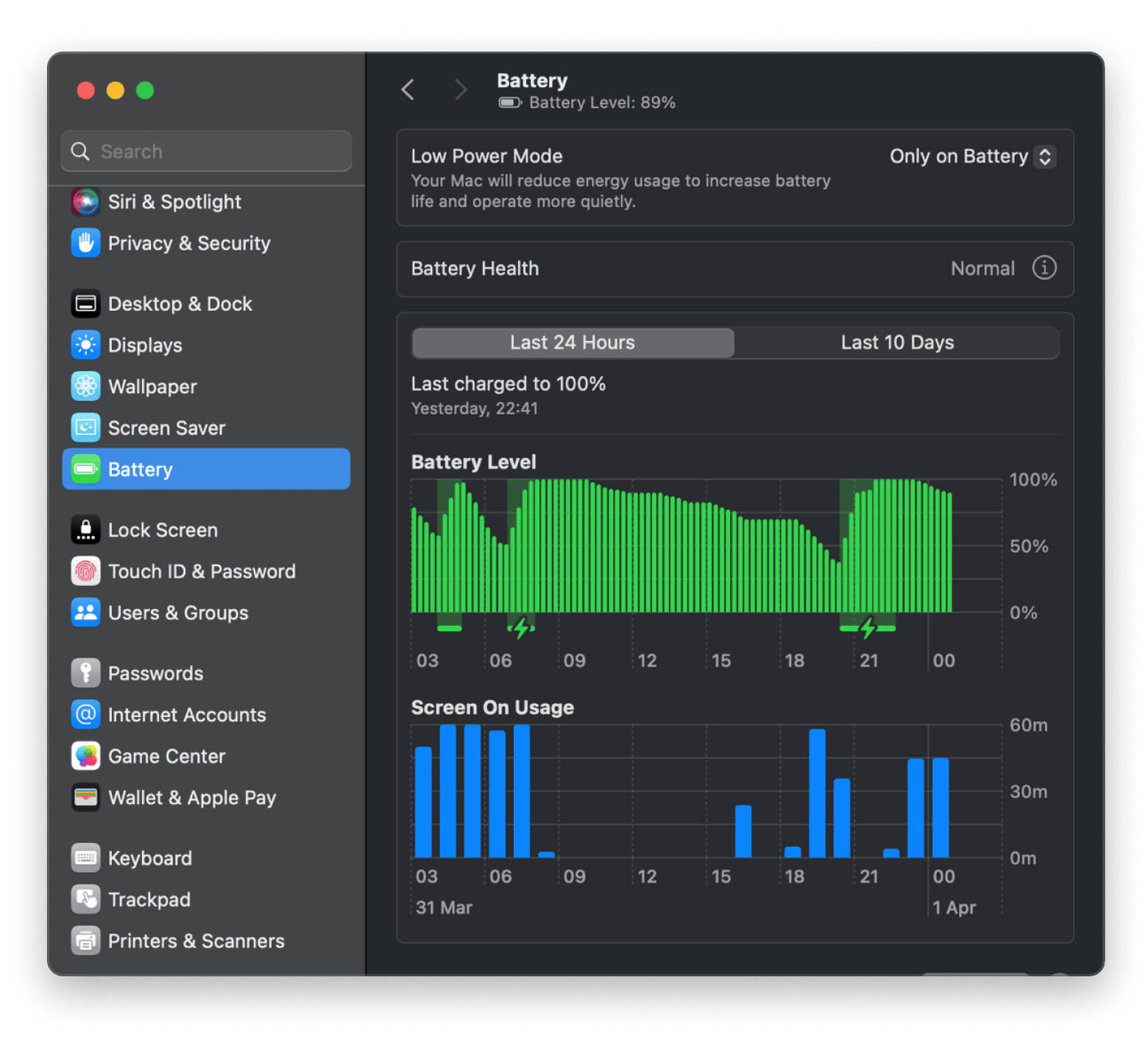
When battery health is indicated as Normal, everything is fine. If battery health is described as Service Recommended, your battery has started deteriorating and will soon need replacement.
Method 2 – Using System Information
The second method for checking your MacBook battery health is using the System Information app, a built-in utility in macOS that offers detailed insights into your Mac's hardware and software components.
Here's how to do it:
- Hold the Option key and click the Apple menu.
- Choose System Information > Power (under Hardware).
- Look for Cycle Count and Condition.
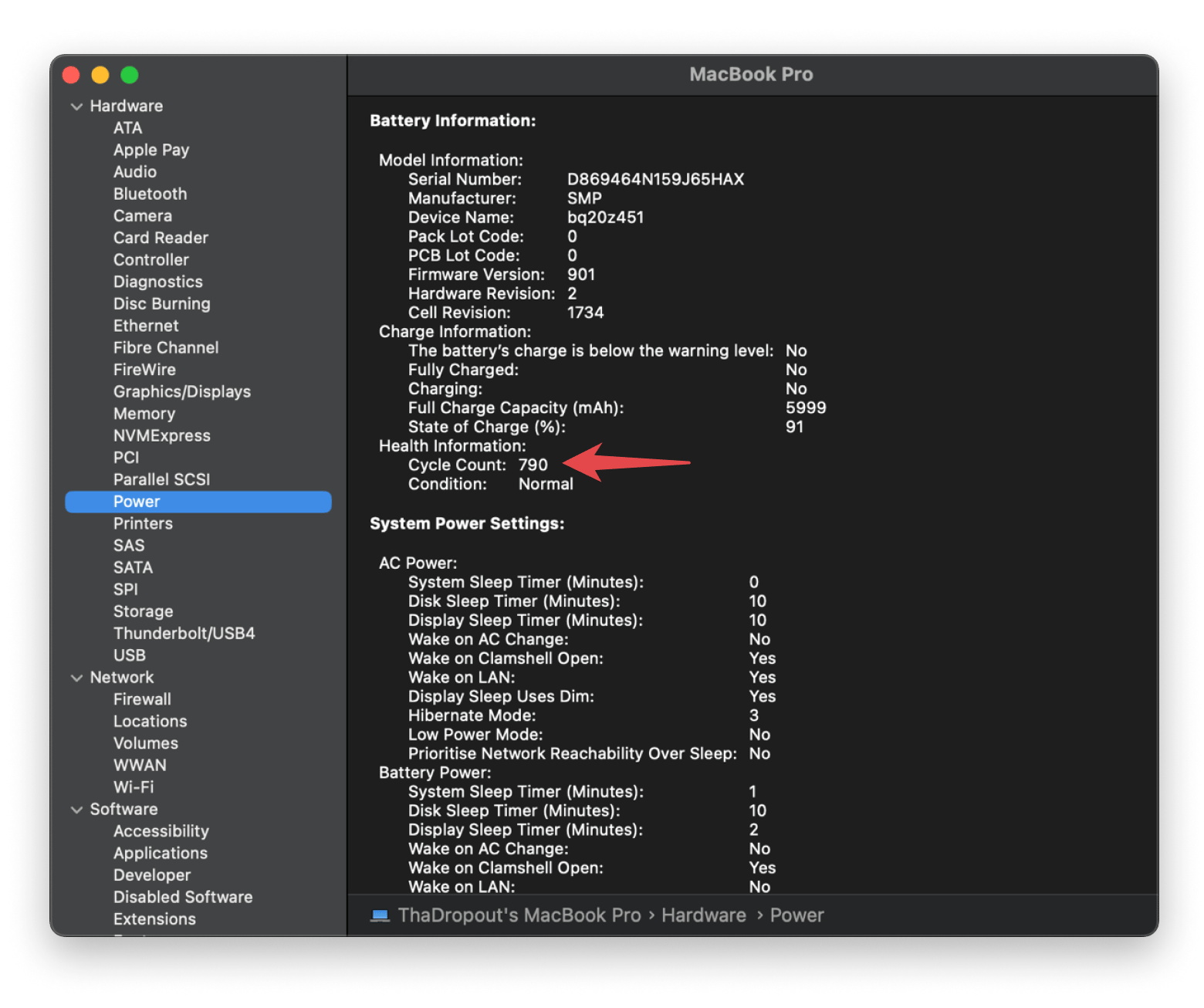
If your battery’s cycle count is above 1,000, it's no longer as efficient because its maximum charge capacity has started dropping.
While you're at it, you might also want to see your battery percentage at a glance. If you’re wondering how to show the battery percentage on a Mac, this full guide walks you through it step by step.
How to extend MacBook battery life
No, extending your MacBook’s battery life isn’t a myth. There are a few things you can do to help keep it healthy for longer. I’ll go over them in the section below. Each method varies in how effective or convenient it is, so just pick the ones that fit your routine.
Enable Low Power Mode
You know how, when your laptop is not working, everyone's first advice is to turn it off and on? Well, the first piece of advice everyone would give you for extending your laptop's battery health is to enable Low Power Mode. It's quick and easy, and if you’ve been wondering how to save battery on your MacBook, this is one of the simplest ways to start. The science behind it is simple: it reduces background activity and lowers system performance slightly to help your battery last longer.
To engage Low Power Mode:
- Click the Apple menu in the top-left corner.
- Choose System Settings > Battery.
- Select your preferred option from the right-hand drop-down menu next to Low Power Mode.
- Choose from four options: Never, Always, Only on Battery, or Only on Power Adapter.

If you select Only on Power Adapter, Low Power Mode will turn on while your Mac is plugged in. This is a great option if you want to save power while still getting a full charge before heading out.
The Only on Battery option is recommended if you often deal with power outages. It helps your battery last longer, so you can keep working or watching content without running out of power too quickly.
Close power-hungry apps
"Power-hungry apps" might sound scary, but they're just apps that eat up your battery faster than others. The good thing is that you can easily find out which apps are consuming plenty of power and close them.
Here's how to do it:
- Press Command + Space to open Spotlight.
- Search for Activity Monitor and open it.
- Choose the Energy tab at the top of the app window.
- Focus on the Energy Impact and 12 hr Power fields and choose the processes with the highest figures that you don't need to run.
- Click the “X” (stop) button at the top of the app window, then click Quit or Force Quit on the prompt.
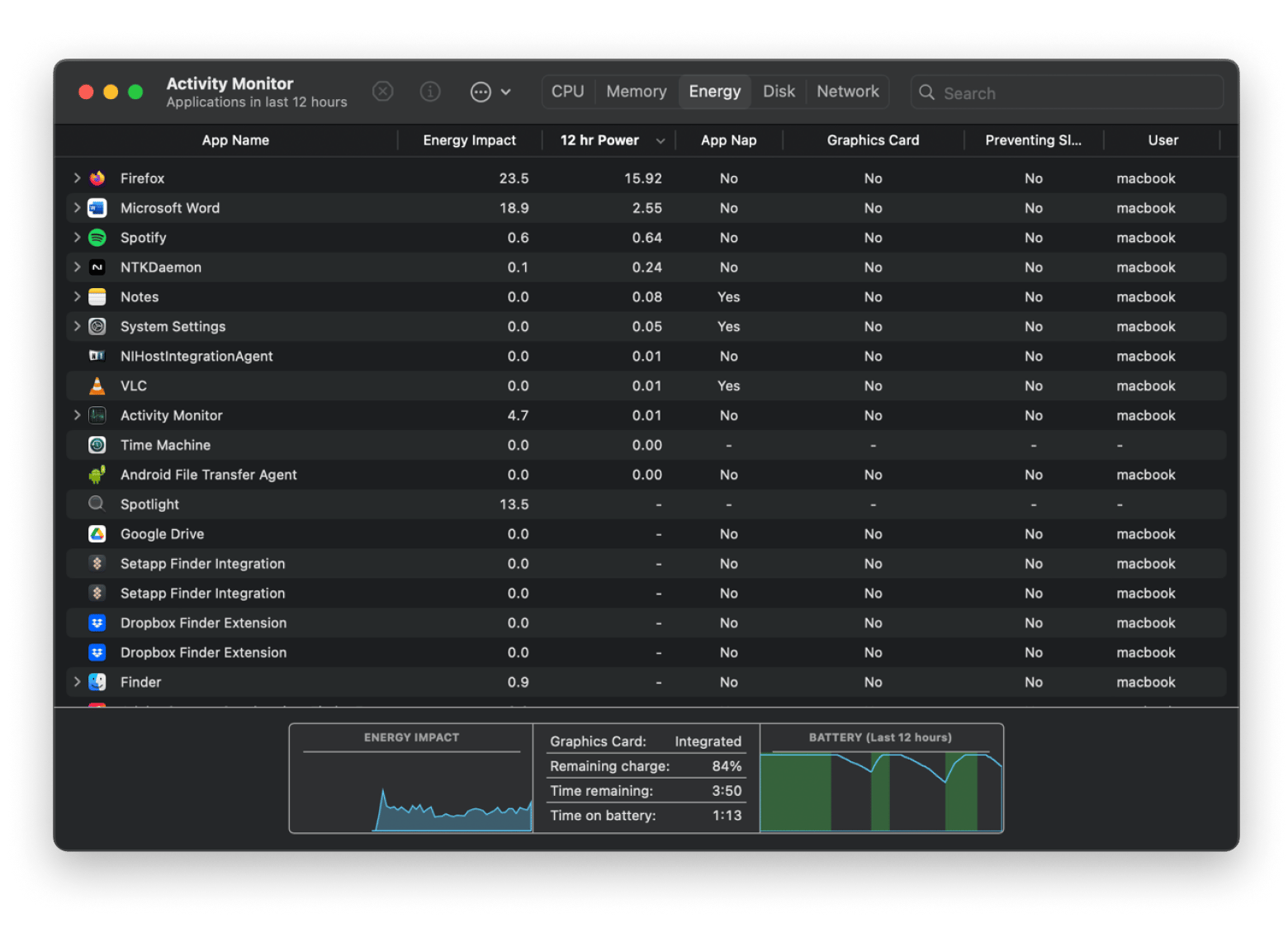
Reduce screen brightness and keyboard backlight
Lowering brightness is good for your eyes, but did you know that it's also good for your battery life? A bright screen and keyboard backlight consume lots of power, even when you're not doing CPU-intensive work.
To reduce screen brightness:
- Click the Apple menu in the top-left corner.
- Choose System Settings > Displays.
- Drag the brightness slider to the left to reduce the screen brightness. Alternatively, you can use the brightness keys on your keyboard or the slider/icons on the Touch Bar if your Mac has one.

Adjusting brightness, turning things off, managing background activity — all add up, and honestly, it’s easy to forget. In those moments, you wish you had a magic wand to handle it all for you.
Well, there are apps that come pretty close. For example, Endurance can automatically dim your screen, reduce CPU usage, and limit background activity to help save battery without you lifting a finger. You can adjust Endurance’s preferences right from your System Settings window:
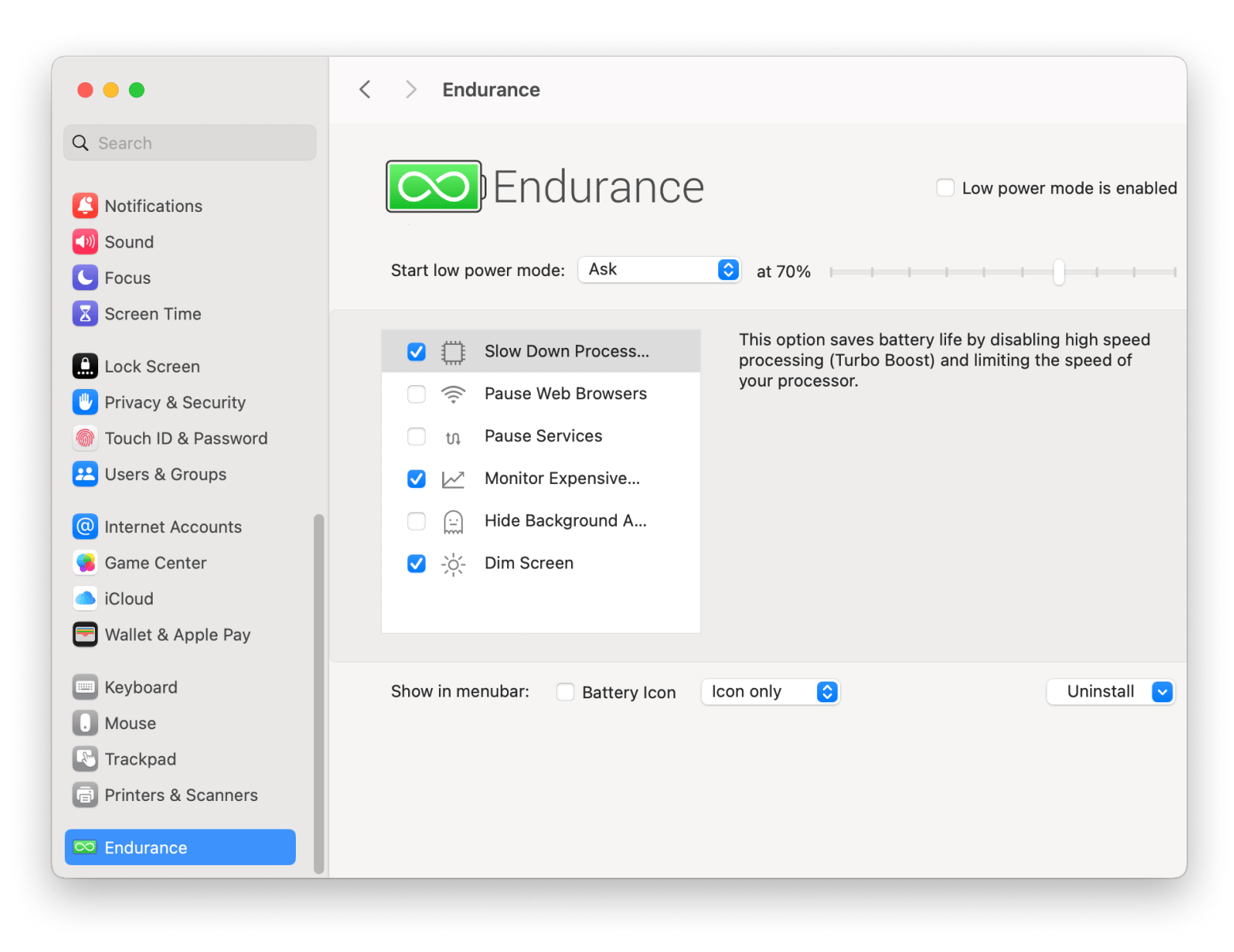
Keep macOS updated
New macOS updates don’t just boost security and make your apps look and perform better. They also improve battery efficiency and enable you to extract more from your Mac without quickly draining your battery and aging it faster.
To keep your macOS updated, here's what you should do:
- Click the Apple menu in the top-left corner.
- Choose System Settings > General > Software Update.
- Click Upgrade Now on the suggested updates.
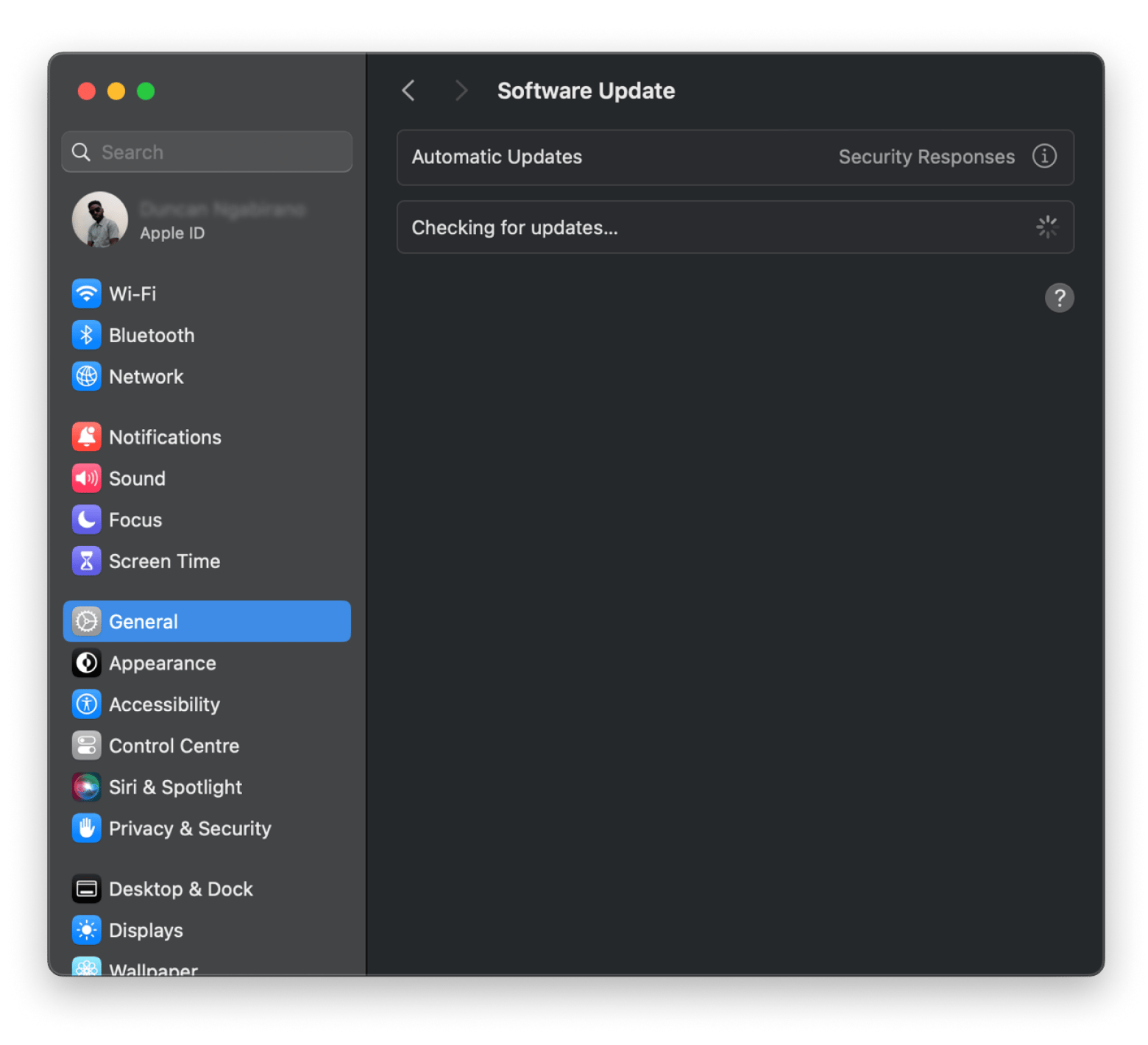
Why checking MacBook battery health matters
MacBook batteries can only go through so many charges before they start to wear out. After about 1,000 full charges, your battery will only hold around 80% of what it could when it was new.
As you rack up more cycles, the percentage of the original maximum charge it can hold will keep dropping. A weak battery can drain super quickly, slow down performance, and even cause unexpected shutdowns.
Luckily, macOS provides a simple way to check Mac battery health and know whether it needs servicing, and we’ll see how in the next section.
Understanding battery cycle count
Now that you know how to check battery health on MacBook systems, you’re probably wondering, “Will my Mac only count another cycle when I charge my battery to 100%?” Well, not quite. Your Mac will add another cycle to the count each time you use 100% of your battery.
For example, if you charge to 90%, use 50%, then recharge to 80% the next day and use another 50%, you’ve used 50 + 50, which makes one cycle. Most modern Apple batteries will give you 1,000 cycles before the performance starts to decline.
When to replace a MacBook battery
I know how you must be feeling. On one hand, you don’t want to replace your battery before getting enough value out of it, but on the other, you also don’t want it to fail completely.
In the past, I’ve had to redo unsaved work, reset my clock, and take longer to resume live performances because of abrupt shutdowns, and it’s never fun. To avoid the same things happening to you, look for these signs to know that it's finally time to replace your battery:
- It drains very quickly, even after a full charge, and without running energy-intensive processes.
- macOS shows a “Service Recommended” message when you check Mac battery health.
- Its cycle count is well over 1,000 cycles, and its life has been reduced.
- The MacBook shuts down unexpectedly even when the battery percentage is high.
If you’ve encountered any of these signs, don’t worry. Apple offers battery replacement services, and you can check eligibility by visiting Apple's support website and entering your MacBook's serial number. If your device is out of warranty, Apple can provide paid battery replacement services.
Getting the most out of your MacBook battery health
To wrap things up, if you want your battery to last longer, it really comes down to keeping an eye on a few key battery metrics. Knowing your battery health on Mac helps you spot issues early or figure out when it’s finally time for a replacement.
If you don’t feel like checking all this stuff manually, no worries, there are apps that do the work for you. iStat Menus shows you detailed stats, Endurance helps manage power use in the background, One Switch lets you toggle battery-saving settings fast, and Usage gives you a quick look at battery health and cycle count.
The best part? You don’t have to install them one by one. They’re all included in Setapp, a platform with 250+ Mac and iOS apps. There's a free trial, so it’s worth checking out.
FAQs
How do I check MacBook battery health?
You can check Mac battery health by going to System Settings > Battery. You can also use apps like iStat Menus and Usage for more detailed insights.
Why is my MacBook battery draining fast?
If your MacBook battery draining fast, the answer usually lies in a few common reasons:
- Your battery cycle count is way past 1,000.
- You leave many energy-intensive apps and background processes running.
- You keep your screen brightness and keyboard backlight high.
When should I replace my MacBook battery?
You should replace your MacBook battery if:
- Your battery’s cycle count is way over 1,000.
- Your battery drains quickly even when fully charged and underworked.
- Your MacBook shuts down unexpectedly when the battery level is still high.
- Your macOS shows a “Service Recommended” message when you check Mac battery health.





